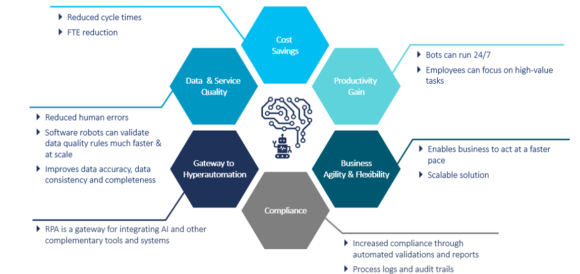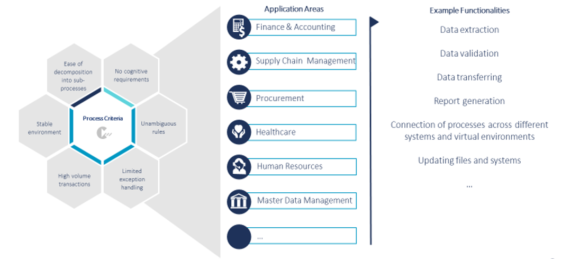In our first blog article on Robotic Process Automation (RPA) we introduced four key pillars which we consider to be essential for the long-term success of an automation project: Processes, Data, People and Technologies. As each of these key pillars is important to build a solid base for an RPA project and its later success, one must be able to combine their strengths and bridge the gaps between them. Therefore, it’s necessary to have a closer look on each of the four key pillars. This blog article focuses on the first pillar It also sheds light on one of the most acute problems with RPA: why are so many tempted to kickstart automation with non-profitable processes? To avoid this problem and select only suitable and profitable processes, we introduce three main steps to take before the automation itself can be started.
Key drivers for Robotic Process Automation
According to Gartner, RPA is one of the fastest growing segments in the enterprise software market. But what are the key drivers for decision makers to invest in an RPA solution? Referencing to Gartner’s survey results (2020), the top three reasons are:
- Optimize operational efficiency
- Accelerate an existing process
- Optimize cost
Hence, the process efficiency shall be increased, process cycle times and operational costs shall be decreased. And if we have a closer look on the common business benefits of RPA, these are reasonable points. The main benefits are captured and clustered in figure 1.  Figure 1: Business Benefits of Robotic Process Automation
Figure 1: Business Benefits of Robotic Process Automation
Implemented correctly, RPA can fasten cycle times and eliminate manual errors which naturally occur when boring and standardized tasks must be performed repeatedly. RPA bots are purely rule-based and therefore operate error-free as long as the underlying processes and its data are error-free. Since RPA is integrated across IT systems via front end and doesn’t need to create new APIs to communicate and connect with other IT-systems, it can be implemented in a comparable fast manner. As a result, RPA can lead to a fast value creation and ROI outcome. However, to achieve these desired outcomes and the related business benefits, it is important to have a process perspective from the beginning. The start of the project and the preparations for the set-up have an immense impact on its later success. The introduced business benefits seem obvious and might drive a person in charge to kickstart the automation of a process to fast with the first process that comes to mind. Thus, it is not surprising that the selection of wrong use cases (processes) is still one of the main reasons for failed RPA projects.
The importance of having a process perspective: Three steps to select the most profitable processes
As the name suggests, processes are at the core of RPA. But a major pain point that companies face today is that the processes are not always well documented or even broken at some point. Identifying processes that are most suitable and profitable for automation is a key activity for RPA projects. Having a high level of transparency about your business processes is key for success. For this reason, we strongly recommend following three steps before starting the automation itself:
Step 1: Scan process landscape
The first essential step is to provide a process backlog for all processes that are in the respective scope of the project. A process backlog must consist of a short description of every process and list all relevant stakeholders. These stakeholders are essential as they serve as key interview partners to understand the complexity of the process and to identify existing gaps. In case of existing gaps, the missing information and documentation must be acquired. In the end, every process must be depictable as flow chart including all existing exceptions. In reality, a process has often more exceptions than initially expected. In order to identify existing process exceptions and to calculate the degree to which a process is carried out according to the standard process description, complementary technological solutions such as process mining are essential.
Step 2: Identify automation potential and prioritize processes
RPA can be applied to a variety of business processes along different industries and functions. The criteria to select a process for automation are not related to the application area, but to the intrinsic characteristics of the process itself. At CAMELOT, we focus on several criteria to measure the suitability of a process for automation:
- No cognitive requirements: RPA can only automate rule-based decision processes.
- Unambiguous rules: The rules must rely on unambiguous and not on subjective or analytical criteria.
- Limited exception handling: The less exceptions a process has, the easier and faster it can be automated.
- High volume transactions: The higher the volumes of a transactions are, the higher the value generation through RPA will be.
- Stable environment: The process should have a stable system- and IT-environment and should not be subject to constant changes.
- Ease of decomposition into sub-processes: The whole process must be depictable as flowchart.
 Figure 2: Process criteria for Robotic Process Automation
Figure 2: Process criteria for Robotic Process Automation
Assessing these criteria and calculating an overall process suitability score is important to get a first answer to the question if a process is likely to be automated by RPA or not. Next, a strategy for prioritizing the processes to be automated is crucial. This strategy should consider various complexity factors (e.g. the data input type or the number of screens involved) in order to assess the feasibility and time required to automate the process. In addition, the expected business benefits (see figure 1) of the process should be assessed. By comparing complexity factors and business benefits, a prioritization of the processes can be derived.
Step 3: Reengineer, standardize, optimize and digitize processes
Unfortunately, the third and last step is often neglected, and a project starts directly with the design of the automated to be processes. However, it is important to first optimize the processes and decide for which part RPA is the right choice and which part could be optimized through process reengineering. Even if a process has a high potential for automation, it does not mean that the entire process must be automated solely through RPA. Ensure that you are aware of what the involved applications are capable of and what not. Many applications have pre-configured functionalities to automatically trigger specific actions within an app. Thus, making use of these functionalities can save develop time. In addition, an automation initiative is the perfect and last opportunity to reengineer and optimize the process before automating it. Identify if your process contains unnecessary or inefficient steps and remove or replace them. By automating an inefficient process, the inefficiencies will simply be carried out again and again. The more standardized and digitized a process is, the faster cycle times you can achieve. With regards to the frequency with which a process is carried out, this can be the key differentiator which brings you ahead of your competitors. CAMELOT offers a holistic approach for RPA enterprise information management and can support organizations with our experience during different stages of exploration or implementation in the context of hyperautomation. For further information please get in touch with us.
We would like to thank Bhavana Jotwani for her valuable contribution to this article.

